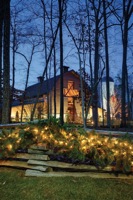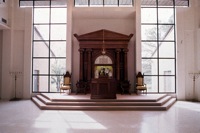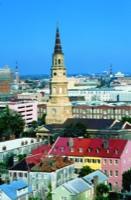 Photo courtesy Cane Ridge Preservation Project
Photo courtesy Cane Ridge Preservation Project
It must have been quite a sight to behold at Cane Ridge Meetinghouse when tens of thousands of people gathered in rural Kentucky for a series of revival meetings in 1801. With dozens of preachers, along with singers, prayer groups and vendors, this historic revival could have had all the trappings of a major festival.
Instead, the meetings at Cane Ridge helped to spark the spiritual movement known as America’s Second Great Awakening. During the rest of the century, religion grew, diversified and flourished throughout the South, a region of the country that is still known for its strong faith.
In Kentucky, Tennessee, South Carolina and numerous other Southern states, visitors can trace the growth of the religious tradition that became such an integral part of the region’s character. Whether they choose to visit the Jewish synagogues of rural Mississippi or the home of an international evangelist in North Carolina, church groups will find plenty of places to explore their religious heritage during a trip through the South.
Cain Ridge Meetinghouse
Paris, Ky.
Kentucky Presbyterians planned a revival event for the summer of 1801 at Cane Ridge Meetinghouse near what is the present-day town of Paris. They invited ministers from around the country, as well as the public, and ended up with a seven-day affair of large proportions.
“It was the largest revival of the day,” said James Trader, curator of the Cane Ridge Preservation Project. “Estimates put it at 25,000 to 30,000 attendees during the course of a seven-day period. Many people have called it America’s second Pentecost, because of the behaviors, and the Second Great Awakening.”
Accounts from the time say that approaching the ridge was like approaching the roar of Niagara Falls and that there were so many torches in the trees that it looked as if the forest were on fire. The preachers and congregants were joined by vendors selling goods and food, as well as numerous onlookers who reported the events in newspapers nationwide.
The meetings eventually led to the beginning of several new denominations, including the Church of Christ and the Disciples of Christ. Today, church groups that visit the site can see the original meetinghouse and learn more about the events that took place there.
“The meetinghouse is still here, and it has been restored to roughly its 1790s experience,” Trader said. “We also have a museum with several artifacts from the church itself and a few papers and photographs. We have a room full of tools that show what they would have used to build the church.”
The meetinghouse is now protected by a stone structure that was built around it to protect it from the elements and the threat of fire.
Billy Graham Library
Charlotte, N.C.
In 1927, William Franklin Graham spent about $9,000 to build a small house on his farm near Charlotte, N.C., where he would raise his family. His son Billy spent most of his childhood in that home before growing up to be the most famous evangelist in modern America.
 |
| Courtesy Billy Graham Library |
Today, the Billy Graham Library in Charlotte has a wealth of information and exhibits on Billy Graham’s life, including the childhood home.
“We do actually have the Graham family homeplace on our property,” said Debra Cordial, director of the Billy Graham Library. “Billy actually lived in the home from the age of 9 until he went off to college at the age of 17. It has the original hardwood floors and bricks and a lot of original furnishings. It looks much the same way that it did until Billy’s mother passed away.”
Today, touring the family home is just one component of discovering the life of Billy Graham at the site. In the library’s museum section, exhibits re-create elements of the family dairy farm, as well as other settings and events from later in Graham’s life. The library itself is shaped like a barn, and the front doors are cut out in the shape of a cross.
“We have what we call the Journey of Faith tour,” Cordial said. “It follows Billy’s life from the time he was called to preach. It takes you to Ruth’s [Billy’s wife] room, which explains how they met, and then we go through a section called ‘The World Discovers Billy,’ which talks about how he used media to reach people.”
Special artifacts on display at the museum include Ruth Graham’s engagement ring and a Bible from which Billy preached during one of his crusades.
Institute of Southern Jewish Life
Jackson, Miss.
Christianity wasn’t the only religion to flourish in the South during the 19th century. In Jackson, Miss., the Institute of Southern Jewish Life tells the story of the Jewish congregations and communities that sprang up in cities throughout the region.
 |
| Courtesy Institute of Southern Jewish Life |
“Most Jewish immigrants settled in cities in the North, but a significant minority came to the South,” said Stuart Rockoff, director of the institute’s history department. “Beginning in the 1840s, you had them spreading out throughout the South usually as peddlers or merchants. So by the 1870s, any significant market town had a small Jewish population, usually owning stores.”
Synagogues sprung up in these Jewish communities, but by the late 20th century, many of them began to close as the populations aged. So about 20 years ago, the Institute of Southern Jewish life was founded to preserve artifacts and historic items from the closing synagogues and to educate visitors about the Jewish heritage in the South.
The main exhibit at the museum tells the story of Jewish immigration from the Alsace region of France to the South. Displays include information on the communities the Jewish immigrants built and the religious legacy they left behind.
“The centerpiece of the museum is a big room that is actually a functioning sanctuary and synagogue,” Rockoff said. “Everything in there comes from a synagogue that was closed. We have pulpits, chairs, menorahs and a wonderful old prayer book that’s in French and Hebrew.”
Charleston, S.C.
Travelers interested in church history will find no shortage of fascinating sites to visit in Charleston, S.C., a historic mecca that claims many firsts for religion in the South.
 |
| Courtesy Charleston CVB |
“In Charleston, we’re called the Holy City,” said Ruth Miller, a local guide who specializes in the city’s religious history. “We were the first English colony south of Virginia, and our founding orders give us this incredible religious freedom. All it took was seven people to start a church, and that explains why we have so much variety.”
Miller takes groups on religious history tours of the city, pointing out sites that are significant both architecturally and as the homes of early congregations. Among highlights is St. Michael’s Anglican church, which was completed in 1761 and attended by both George Washington and Robert E. Lee. Another significant stop is the Huguenot church in downtown Charleston, which was established by French Protestants and was the first grand gothic building in the city.
The oldest Roman Catholic congregation in the English-speaking South built its current church in 1838 in traditional European style, with gold leaf and frescoed ceilings. That same year saw the construction of a Jewish synagogue downtown as well.
“We have this unbelievable religious history here,” Miller said. “Across the street from the Roman Catholics, we have Beth Elohim, which is the oldest synagogue building in continuous use in the United States. It’s a beautiful Greek revival temple built in 1838, and they have a really nice museum of southern Jewish history in that same building.”
Gloryland Road
Southeast Tennessee
Religious groups were integral to the history of Tennessee. The Southeast Tennessee Tourism Association has created a trail called Gloryland Road, which traces the history of numerous groups in the area, including Church of God, Pentecostals, Seventh Day Adventists, Jews and a host of others.
 The trail includes a number of historic churches in Southeast Tennessee, such as an 1852 Methodist church in Chattanooga and a Presbyterian church in the town of Charleston that was used as a Civil War hospital. But it also features a number of other interesting stops related to the area’s religious history.
The trail includes a number of historic churches in Southeast Tennessee, such as an 1852 Methodist church in Chattanooga and a Presbyterian church in the town of Charleston that was used as a Civil War hospital. But it also features a number of other interesting stops related to the area’s religious history.
“One thing that’s fun and resonates with a bunch of people is the idea of religion on the roadside,” said Cindy Milligan, executive director of the tourism association. “Back in the day before you had billboards and humongous churches, you would have crosses that people would put on the side of the road.
“We have one called the Mays ‘Get Right with God’ cross. It was put up by Henry Mays, a coal miner and sign painter. He started constructing these signs in 1918, and some of the signs are still relevant and out there in Tennessee.”
Another interesting site included on the trail is the Children’s Holocaust Memorial at Whitwell Middle School. The memorial was started by a group of eighth-graders who began collecting paperclips to symbolize the Jews killed during the holocaust. Today the memorial includes more than 6 million paperclips sent from around the world, as well as a railroad boxcar and outdoor sculptures.










